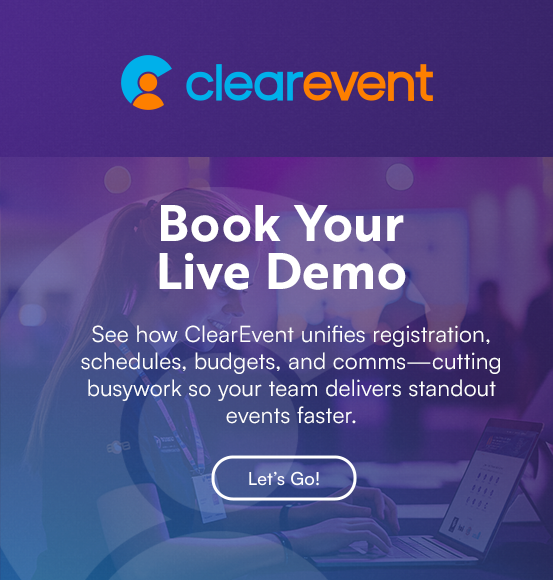Planning a Large-Scale Event? Team Collaboration Is the Key to Success

Planning a large-scale event is complex but with strong team collaboration, clear communication, and the right event planning tools, it doesn’t have to feel overwhelming. Whether you’re a non-profit event organizer working with volunteers or a corporate planner coordinating multiple departments, the secret to success is keeping your team aligned and connected.
Here are eight practical tips to improve team communication for events, assign clear roles, and stay on track with actionable steps you can put into practice right away.
1. Set Clear Team Roles
When everyone knows their role, confusion drops and accountability rises. One of the biggest risks for large events is overlap, multiple people assuming the same responsibility or, worse, nobody taking ownership.
Actionable Steps:
- Use a skills matrix to assign tasks based on experience and strengths.
- Balance responsibilities with growth opportunities, giving team members stretch tasks without risking critical deadlines.
- Review roles weekly to confirm everyone is aligned.
Example Skills Matrix
| Role | Responsibilities | Key Skills |
|---|---|---|
| Event Manager | Coordination, budget management | Leadership, planning |
| Creative Lead | Branding, visuals, stage design | Design, storytelling |
| Logistics Coordinator | Venue setup, vendor scheduling | Organization, problem-solving |
| Tech/AV Director | AV equipment, live streaming, digital tools | Technical expertise |
| Registration Manager | Check-in, ticketing, attendee support | Customer service, detail-oriented |
2. Keep Team Communication in One Place
Too many channels = missed updates. Centralize all team communication in a single hub or event dashboard. Think of this as your command center where everyone sees real-time updates.
Best Practices:
- Use dashboards to track task progress, schedules, and resources.
- Create dedicated channels for logistics, sponsorships, and attendee experience.
- Document all major decisions in one place for transparency.
Tip for non-profit event organizers: Centralizing updates helps when volunteers rotate in and out. They can quickly get up to speed without long handovers.
3. Choose the Right Event Planning Tools
The tools you choose make or break event collaboration. Avoid juggling spreadsheets, email chains, and disconnected apps. Instead, look for event planning tools that integrate tasks, communication, and reporting.
Features to Look For:
- Task management: Assign jobs, track deadlines, set reminders.
- Built-in messaging: Reduce endless email threads.
- Budget tracking: Monitor real-time expenses and revenue.
- Mobile access: Enable on-the-go updates for teams onsite.
- Event dashboard: Provide visibility across teams, vendors, and sponsors.
4. Build Strong Team Relationships
Technology helps keep teams organized, but true collaboration thrives on trust and connection. Strong relationships reduce friction and improve morale when stress levels peak.
Practical Ideas:
- Daily stand-ups: Quick updates to surface blockers.
- Cross-team meetings: Ensure marketing, logistics, and sponsorship teams stay aligned.
- Feedback sessions: Short, focused opportunities to discuss challenges and wins.
- Team-building: Run mock event simulations or scenario-based exercises that directly strengthen event-day collaboration.
5. Create a Detailed Event Schedule
A detailed schedule keeps your team synchronized. Break planning into clear phases with deadlines, and check progress frequently.
Sample Timeline
| Phase | Timeline | Key Actions |
|---|---|---|
| Initial Planning | 6–12 months out | Budget, venue, vendor research |
| Development | 3–6 months out | Assign teams, contracts, risk review |
| Final Prep | 1–3 months out | Training, tech tests, vendor check-ins |
| Event Execution | Event week | Daily briefings, live updates |
Practical Tip: Use your event dashboard to track progress in real-time. Automate reminders for deadlines, and adjust timelines as needed to avoid bottlenecks.
6. Share Live Event Updates
Large-scale events move fast. Real-time team communication is essential for adapting to last-minute changes.
Best Practices for Mobile Updates:
- Use push notifications for urgent updates.
- Standardize formats (e.g., “Location + Change + Next Step”).
- Assign backup contacts for critical roles.
- Track resources like staff assignments and inventory through your event dashboard.
7. Learn from Team Feedback
Your event doesn’t end when the lights go out. Post-event feedback is critical for improving collaboration.
How to Collect Feedback Effectively
| Feedback Type | Timing | Purpose |
|---|---|---|
| Quick Surveys | During event | Address immediate concerns |
| Team Debriefs | Within 48 hours | Surface key lessons |
| Individual Check-ins | Within a week | Address personal experiences |
Turn Insights into Action:
- Categorize feedback into communication, operations, resources, and technology.
- Fix small issues quickly, and build long-term improvements into next year’s plan.
- Share results back to your team so they know their feedback matters.
8. Make Events Accessible for Everyone
Inclusive planning ensures all team members, and attendees, can fully participate. This is especially important for non-profit event organizers working with diverse volunteer groups.
Accessibility Checklist:
- Visual: Screen readers, high-contrast visuals, large fonts.
- Hearing: Live captions, ASL interpreters, proper mic use.
- Mobility: Accessible pathways, adjusted schedules.
- Communication: Offer instructions in multiple formats.
Tip: Collect accessibility needs during registration so accommodations are planned in advance.
Collaboration Creates Better Events
Strong team collaboration and clear communication are what turn complex plans into memorable experiences. With the right event planning tools, a centralized event dashboard, and a culture of open communication, you’ll keep your team focused, reduce stress, and deliver a smooth event.
Quick Action Plan
- Centralize communication in one dashboard.
- Assign clear roles and responsibilities.
- Use integrated event planning tools to manage tasks, budgets, and schedules.
- Collect feedback and improve continuously.
Ready to simplify team communication? Discover how an all-in-one event management software makes collaboration easier and keeps your entire team on track.
Frequently Asked Questions (FAQ)
What are the best event planning tools for team collaboration?
The best event planning tools combine task management, messaging, budgeting, and reporting in one platform. Look for solutions that include an event dashboard so your team can see updates in real time without switching between apps.
How can non-profit event organizers keep volunteers aligned?
Non-profit event organizers often deal with rotating volunteers, so centralized communication is critical. Using an event dashboard with clear role assignments and automated reminders ensures volunteers can quickly catch up and stay on task.
Why is an event dashboard important for large-scale events?
An event dashboard serves as the command center for your team. It provides real-time visibility into task progress, schedules, and resources, helping everyone stay aligned and reducing the risk of missed details.
How often should event teams meet during planning?
Quick daily stand-ups are useful for progress updates, while weekly meetings work best for bigger-picture strategy. During the event week, daily briefings and real-time mobile updates help the team stay flexible and responsive.
What’s the best way to collect team feedback after an event?
The most effective method is a combination of quick surveys during the event, structured team debriefs within 48 hours, and individual check-ins within a week. This ensures immediate issues are addressed while also capturing longer-term insights for future improvements.
